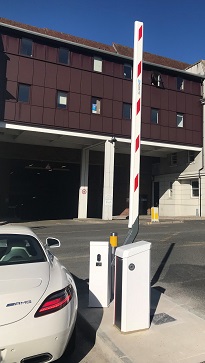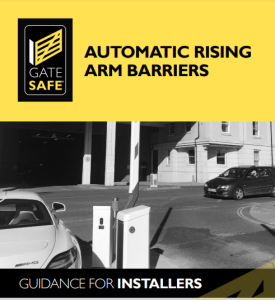Rising arm barriers, as well as swing and sliding gates fall under the legislation described in the Machinery Directive MD 2006/42/EC. Therefore we must make sure the Essential Health & Safety Requirements within the Directive are met to ensure barriers have the same required standard of safety as all other types of systems.
BS EN12453:2017 states that barriers can be excluded from the requirements of the regulations if they are ONLY used by vehicles and not pedestrians. This is often cited as a reason to justify why barriers should not be regulated, but in reality, there are very few barriers that the general public could not come into contact with, the exception to this would be toll barriers on a motorway. Railway crossing barriers are covered by separate legislation.
Gate Safe takes the view that since all barriers are capable of causing injury to members of the general public unless they are properly protected, all barriers are subject to the regulations and any other Gate Safe guidance.
Are there any risks associated with rising arm barriers?
The risks from barriers are many and varied depending on the style and design of the device, but the following are the key hazards associated with this type of installation:
1.Risk of impact as the barrier arm lowers. The risk here is that a pedestrian may not be aware that there is an arm about to lower. This can be mitigated by:
- fitting two pairs of photocells either side of the boom, far enough back to protect a counter balance if fitted
- fitting a safety edge to the underside of the boom
- installing fencing to segregate vehicles and pedestrians
2. Risk of shearing, crushing or entrapment between the barrier and the housing. This risk can be protected against by installing the safety measures detailed above. It is also possible to effectively ‘fence off’ access to the housing.
3. Where a counter balance is fitted, as the barrier raises there is a risk of shearing, crushing and entrapment as the counterweight passes the barrier housing. This can be protected against by the use of non-contact safety items such as light curtains or laser scanners, or physical protection such as suitable meshing.
4. Risk of being hit by the barrier as it raises up. Protection can be provided by photocells. In addition, all barriers should be adjusted so that they operate at the minimum force to open and close, which should hopefully be insufficient to be able to lift a person. Remember if the barrier housing is situated next to a solid object such as a wall or fence, there may be a crushing risk as the arm opens towards it. Again, this can be mitigated by the installation of meshing or non-contact safety equipment.
5. Risk of becoming trapped in the skirt of the rising arm barrier as it raises. Photocells will help to protect against this risk to a degree, but a laser scanner or light curtain may be a better solution if the barrier is in a high risk situation.
As well as the fitting of the above specific safety devices, the installation should be subject to a multiple risk assessment, appropriate signage should be visible (including a flashing light if possible), the barrier installation should have a CE mark added and fencing to segregate pedestrians from the flow of traffic should also be installed. Always remember that there are two sides to the barrier i.e. pedestrians can approach the barrier from both directions!
Any road that features an automated barrier should be clearly marked to signify that the route is suitable for car access only.
To help you navigate this important topic, we’ve put together a FREE guide that breaks down everything you need to know about traffic arm barrier safety. From installation tips to maintenance best practices , to download click here.

